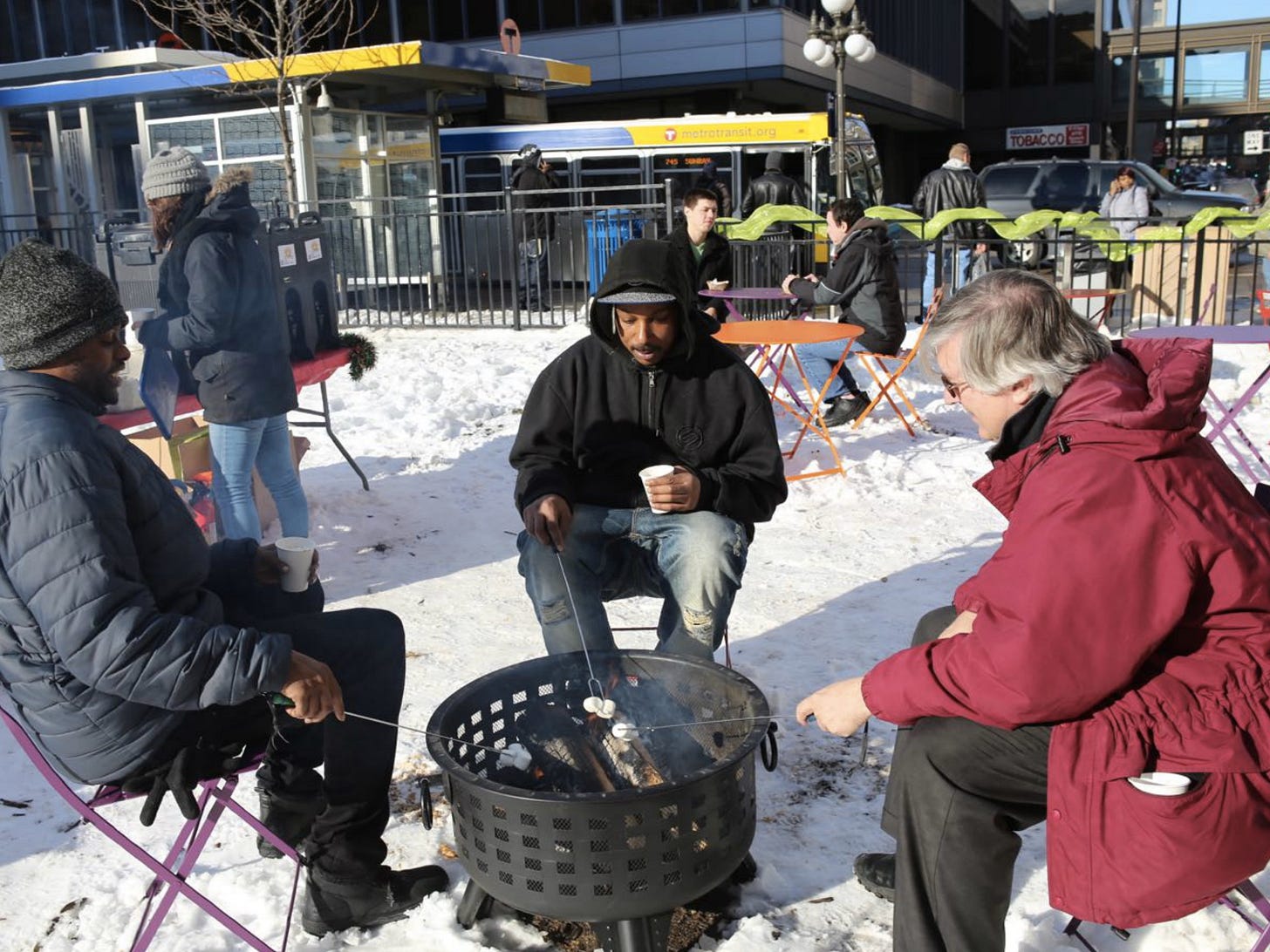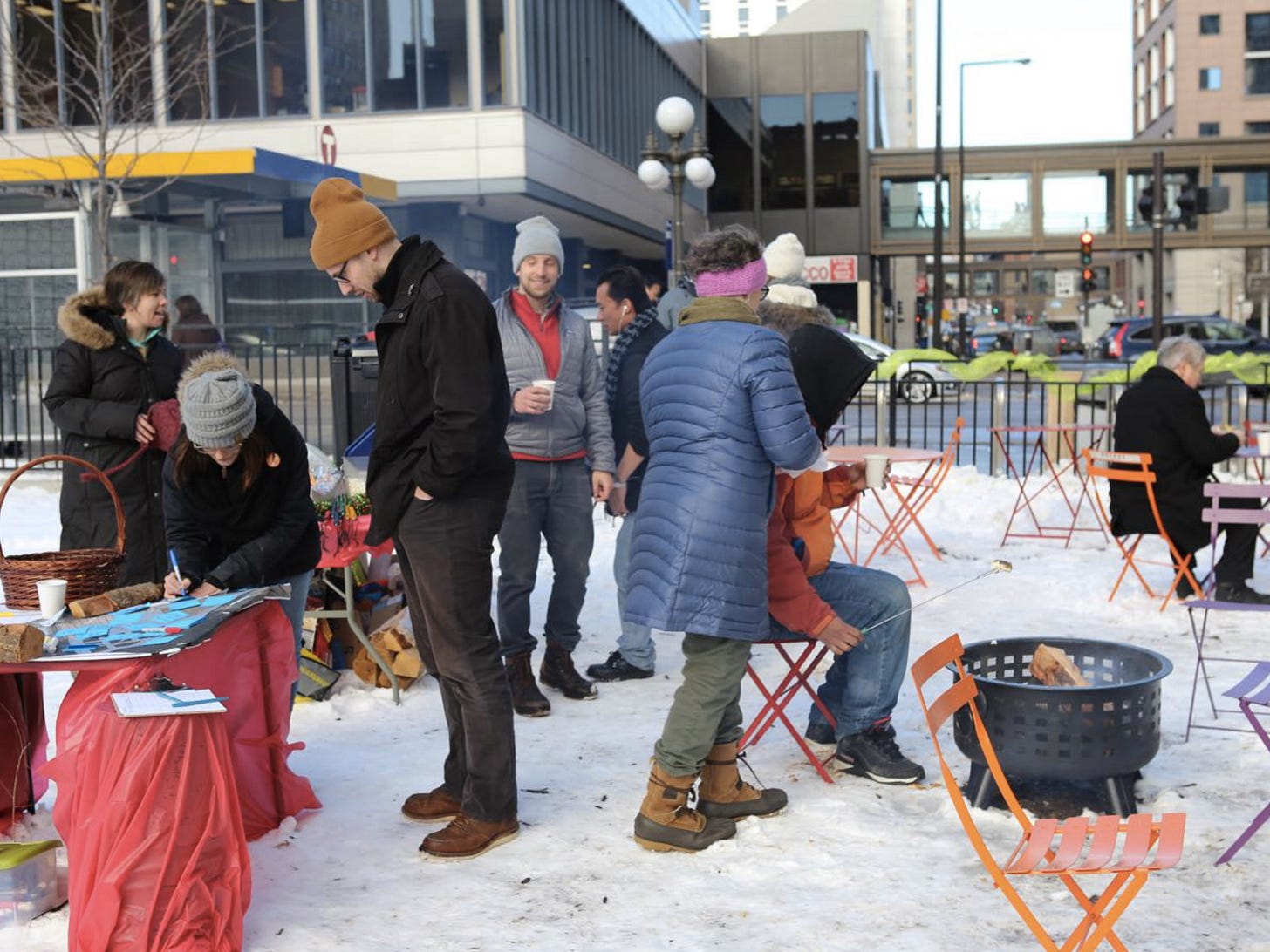Now Take the First Step
Step 4 of Transforming a Place Without Money or Authority
This newsletter is part 5 of a series on our seven-step placemaking process (what we like to call “how to get things done without a lot of money or authority”). If you missed the last part to this series, you can check it out here!

You’ve identified your goals and your resources, and you’ve created your constituency, so now it’s time to implement some improvements. This is cause for excitement, but you may also be wondering where to actually begin.
If you’ve been operating under an “improvements = big, new and expensive” mindset up to this point, you may be used to working with projects that take a long time to materialize and are relatively fixed when (or if!) they do. In such cases, it’s easy for people to get trapped in hypothetical debates, where you put forth your prediction about what’s going to happen if certain steps are taken, and someone else (or several people) have conflicting ideas and predictions.
Start Small and Remember Your Goals and Resources
Instead of getting lost in hypotheticals, identify the first minimally viable step. If you’ve taken the time to reframe your available resources, then you already know what you have to work with. Come back to the main question you put to your constituents: “What experiences do we want to have in this place?” What goals did you identify together, and what step can you take now to work toward that goal with the resources you have at hand?
Think about your response, no matter how small it may be, as a holistically integrated thing.
What do we mean here? Our shared spaces are defined by the type and quality of experiences we have there. These experiences are shaped by physical environments, how well those environments are cared for, and the events that happen there. A successful place has those elements not just present, but each enhancing each other, whereas places we don’t like being in have these same elements, but functioning in relative isolation, without synergy.
Our aim should be to create our desired experiences, and that requires us to act holistically.
For example, if you’re trying to create a safer street, you could install some bollards, and that would be somewhat effective, to be sure. But what would be even more effective is installing some bollards, adding some planters that are cared for by surrounding businesses and residents, and creating a small promo event or communication campaign about the street improvements. That’s a holistic approach that is more beneficial than doing any one of these things in isolation. It’s the integration of placemaking and changemaking, experience and (“small-p”) politics.
Start small, see what happens, take away some lessons from what you observe, and then discuss. People can disagree about the lessons and how to proceed from them, but it’s a much better conversation than disagreeing about unproven hypotheticals. No one will feel like they “lost,” and you can then work better with those people in the future because they don’t feel like losers in an argument.
How This Can Look in the Real World
Let’s look back again at our Central Station example. Even after we’d defined our goals, identified our money and resources, and engaged with our constituents, we still had people involved in the project who were deeply skeptical that the different users of the space could be brought together through shared goals and solutions. So, we decided our first minimally viable action was to test two pilot projects.
Bringing People Together…With S’mores!
First, we hosted a wintertime fire and s’more-making event in December. We brought in some food trucks, set up games like kubb and bag toss, set up a chalkboard for some in-person engagement questions, played music, gave out free hot cocoa and cider and, of course, s’mores! The entire operation cost only $800 ($500 of which went into giving out free beverages, so you could conceivably do this for even less if you need to), and it was a great success. So many people came to enjoy the pop-up event, from city council members and heads of departments, to police officers, community leaders, business managers, and small business owners, to regular transit users and residents.
People saw, in a very real and tangible way, that it was possible to enjoy being at Central Station. Moreover, it became evident that different groups of people could enjoy this space together. Cops were playing bag toss and roasting s’mores with young people who didn’t normally feel comfortable interacting with the police, and decision-makers had an opportunity to actually share this space with the “youth” and transit users.
This is all very powerful because it helped the people who control resources and who are in charge of rules and laws to visualize something substantially different for Central Station than what had previously been there. Not everyone will be able to “get” the vision by looking at something like a rendering, whereas a real-life experience touches people emotionally and helps them to see the possibilities. Moreover, it gave us a real experience (with real data) that we could use as a point of reference when discussing future plans, so we didn’t have to argue over hypotheticals.
Celebrating Love in an Unlikely Place
Second, we did a Valentine’s Day event in the troubled skyway over Central Station. With only $380, we brought in a live musician and free candy, flowers, and art supplies, and we invited people to come enjoy the music and create valentines together. We also used this as an opportunity to build awareness for the project’s newsletter (i.e., building our constituency).
This was significant because no one thought a successful event could happen in a place like this, especially since this was where a lot of the criminal behavior was happening. I was told I was naive, ignorant of the dynamics at play there, that I was out of my mind, and so on. Yet, what we saw in reality was that positive things could happen in this previously awful space, and that past “bad” actors could be prosocial when given the right activities: like everyone else who came through the skyway that day, they also came to our pop-up to make valentines for their loved ones. With one simple event, we replaced the “good people versus bad people” narrative that had been plaguing conversations about Central Station with the more productive and accurate “good behavior, bad behavior.”
In both the s’more-making and Valentine’s Day pop-ups, we were able to demonstrate that residents, office workers, youths, and even police officers could enjoy this public space together. That gave us more momentum to generate buy-in, partnerships, and ease of approvals for the first year of operations. Despite the fact that we only operated for a month during that first year due to regulatory issues, we created enough proof of concept through those initial small first steps to expand our project for three months during the following year.
You Win at Placemaking When the Game Never Ends
And in case you’re still wondering if small can truly be mighty, consider this: we normally treat public improvement projects like a so-called “finite game.” We go all in on a big, one-time project, leave it to succeed or fail, and then oftentimes we don’t do (or simply can’t afford, since the project was such a big upfront cost) the maintenance to keep that space going or to make adjustments to it as needed to meet the users’ desires. This is a losing battle to fight; it invariably results in the degradation of the place over time.
Instead, we must treat placemaking as an infinite game (as coined by James P. Carse in “Finite and Infinite Games”). In other words, the point of the game is not to come to an end, in which there are strict rules and winners and losers. Instead, the point of playing — the metric of success for — this game is for it to continue indefinitely, even if that means having to tweak the rules and boundaries of it at times to prolong its lifespan.
In other words, you don’t need to achieve everything on your first go-around and your project doesn’t need to be some incredible, huge, perfect accomplishment right away. It’s much better and more sustainable to shift to a mindset where any concrete action, no matter how humble, is valuable and will allow you to generate the snowball effect that you need to achieve long-term success.
Once you’ve taken that first step on your path to success, how do you communicate your momentum to others so that they’ll walk alongside you? That’s what we’ll be discussing in our next installment in this series, so stay tuned!



